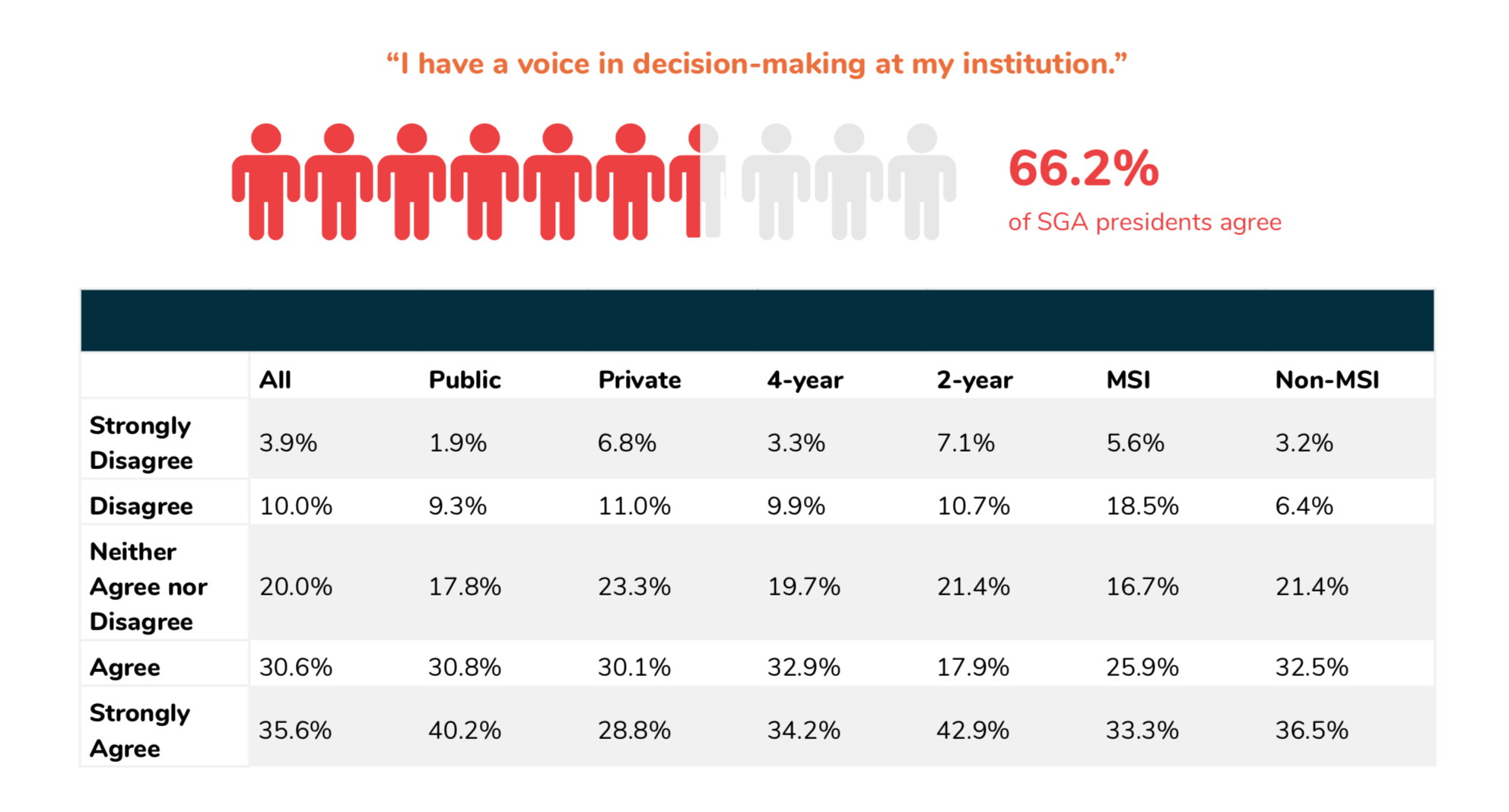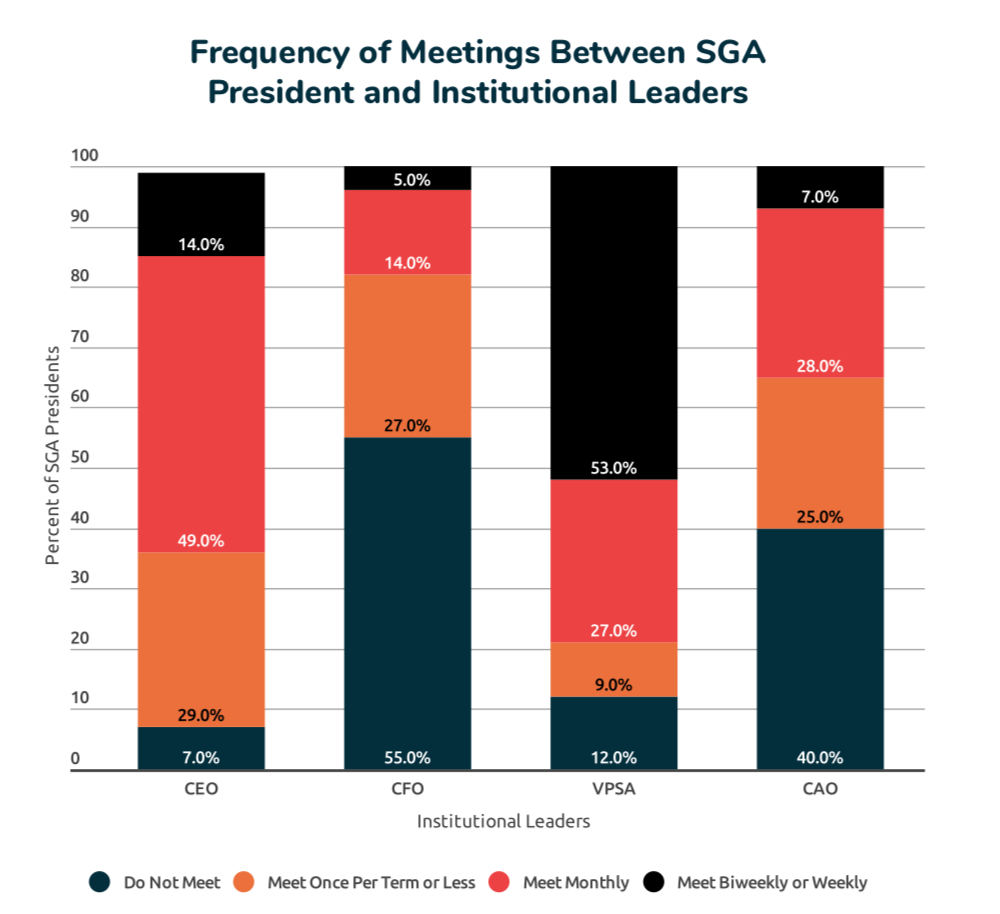You have /5 articles left.
Sign up for a free account or log in.
Student leaders who meet with college and university administrators regularly and have a voice on governing boards feel much more effective, according to new research measuring students’ perceived influence on campus.
The report, released Thursday, comes from the National Campus Leadership Council, a group advocating for more student authority in higher education. Alongside the new study, the nonprofit created the Student Voice Index, which scores institutions on how well they hear student opinions and include them in decision making. The report, and further research, is funded by a $350,000 grant from the Bill and Melinda Gates Foundation.
As issues such as free speech, mental health and race relations have shaken campuses more in the last several years, students have started demanding more access to high-ranking administrators, particularly presidents. For its survey, NCLC focused only on student government presidents, asking more than 200 of them at a range of institutions (both two- and four-year colleges, private and public) whether their institutions valued their views, whether they felt prepared to handle their roles and whether they could speak or vote during governing board sessions, among other questions. Most of the sample was from four-year, public universities. NCLC also analyzed campus policies and bylaws on how much power student leaders have.
Whether the student government head reflects the views of all students is uncertain. As the report notes, the average voting rate for electing a student government president is about 22 percent of a student body and an SGA president’s views or priorities may not align with those of an student activist for minority groups, for instance. SGA presidents spend about two-thirds of their time working on activities given to them by university officials rather than their own agenda, the group found.
Andy MacCracken, a founder and NCLC executive director, acknowledged that his group grappled with this, but he said NCLC wants to make sure that presidents are as representative as possible. Though there are limitations, MacCracken said presidents are a “fairly diverse” group and the demographics in the NCLC sample match that of nationwide statistics. For example, the percentage of presidents who relied on federal financial aid matched the national average, MacCracken said.
NCLC found that about 66 percent of student government presidents felt they “had a voice” in institutional decisions. Roughly 75 percent of them reported that they had the opportunity to raise concerns before a campus issue “got out of hand,” according to the report. About 55 percent of presidents felt “very influential” in decisions.
 When student presidents were involved with the governing board, they also reported feeling a stronger sense of “voice.” A little more than 27 percent of students had both speaking and voting rights on these boards, but most don’t meet personally with the board chairs -- about only 20 percent.
When student presidents were involved with the governing board, they also reported feeling a stronger sense of “voice.” A little more than 27 percent of students had both speaking and voting rights on these boards, but most don’t meet personally with the board chairs -- about only 20 percent.
While 60 percent of the presidents meet with the chief academic officer, and 45 percent meet with the chief financial officer, they reported meeting with the top student affairs professional most frequently -- 88 percent of the presidents meet with a vice president of student affairs, and 53 percent of the presidents met with the student affairs professional biweekly or weekly.
NCLC will be conducting 10 case studies for institutions, a dive into how much power students have on campus. The first, which was already released, focused on Ohio State University. It will also publish additional briefs based off the Student Voice Index research, MacCracken said -- for instance, there were differences between how empowered students felt at institutions serving minority groups versus predominantly white institutions. MacCracken said NCLC is seeking institutional partners to work with on future research, too.
 At a press briefing Thursday, two student government representatives, one from Ohio State and the other from American University, as well as Merrill Schwartz, senior vice president of the Association of Governing Boards of Colleges and Universities’ consulting arm, discussed the findings.
At a press briefing Thursday, two student government representatives, one from Ohio State and the other from American University, as well as Merrill Schwartz, senior vice president of the Association of Governing Boards of Colleges and Universities’ consulting arm, discussed the findings.
Shamina Merchant, the student government president at Ohio State, and Valentina Fernández, American’s student president, said that training for student representatives, such as learning how processes like budget planning and strategic planning work, is particularly important.
Merchant said that over time, through meetings with administrators, students have come to be viewed as equal partners at Ohio State -- when an incident happens on campus, officials will call and ask student leaders for advice, she said.
Schwartz said governing boards have a responsibility seek input from students.
“A small percentage of governing boards have a student representative on that board and have an opportunity to hear from the student representative, but that’s not enough,” she said.




